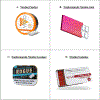Adolescent Use of Flavored Non-Tobacco Oral Nicotine Products
- PMID: 35934731
- PMCID: PMC9994602
- DOI: 10.1542/peds.2022-056586
Adolescent Use of Flavored Non-Tobacco Oral Nicotine Products
Abstract
Background and objectives: Flavored non-tobacco oral nicotine products (eg, nicotine pouches and nontherapeutic nicotine gum, lozenges, tablets, gummies), are increasingly marketed in the United States. Prevalence of non-tobacco oral nicotine product use among adolescents is unknown.
Methods: We calculated prevalence of ever and past 6-month use of nicotine pouches, other non-tobacco oral nicotine products (ie, gum, lozenges, tablets, and/or gummies), e-cigarettes, cigarettes, hookah or waterpipe, cigars, cigarillos, and snus among high school students in Southern California between September and December 2021. Generalized linear mixed models tested associations of sociodemographic factors and tobacco-product use with use of any non-tobacco oral nicotine product.
Results: Among the sample (n = 3516), prevalence was highest for e-cigarettes (ever: 9.6%, past 6-month: 5.5%), followed by non-tobacco oral nicotine products (ever: 3.4%, past 6-month: 1.7%), and <1% for other products. Ever users of combustible tobacco (adjusted odds ratio [aOR] = 77.6; 95% confidence interval [CI] = 39.7-152) and ever users of noncombustible tobacco (aOR = 40.4; 95% CI= 24.3-67.0) had higher odds of ever using non-tobacco oral nicotine products, compared to never users of combustible and noncombustible tobacco. Use of any non-tobacco oral nicotine product was greater for Hispanic (versus all other races/ethnicities except Asian, aOR = 2.58; 95% CI = 1.36-4.87), sexual minority (versus heterosexual, aOR=1.63; 95% CI = 1.03-2.57), gender minority (versus male, aOR = 2.83; 95% CI = 1.29-6.19), and female (versus male, aOR=1.92, 95% CI = 1.20-3.06) participants.
Conclusions: Non-tobacco oral nicotine products were the second most prevalent nicotine product used by adolescents. They were disproportionately used by certain racial or ethnic, sexual, or gender minority groups, and those with a history of nicotine use. Adolescent non-tobacco oral nicotine product use surveillance should be a public health priority.
Copyright © 2022 by the American Academy of Pediatrics.
Conflict of interest statement
Figures


Similar articles
-
Sexual and Gender Identity Disparities in Nicotine and Tobacco Use Susceptibility and Prevalence: Disaggregating Emerging Identities Among Adolescents From California, USA.Nicotine Tob Res. 2024 Jan 22;26(2):203-211. doi: 10.1093/ntr/ntad131. Nicotine Tob Res. 2024. PMID: 37493636 Free PMC article.
-
Prevalence of and disparities in adolescents' susceptibility to novel oral nicotine products marketed as "tobacco-free".Prev Med. 2023 Jan;166:107387. doi: 10.1016/j.ypmed.2022.107387. Epub 2022 Dec 9. Prev Med. 2023. PMID: 36503016 Free PMC article.
-
Flavored Tobacco Product Use and Its Association With Indicators of Tobacco Dependence Among US Adults, 2014-2015.Nicotine Tob Res. 2020 May 26;22(6):1004-1015. doi: 10.1093/ntr/ntz092. Nicotine Tob Res. 2020. PMID: 31180498
-
The Potential Impact of Oral Nicotine Pouches on Public Health: A Scoping Review.Nicotine Tob Res. 2025 Mar 24;27(4):598-610. doi: 10.1093/ntr/ntae131. Nicotine Tob Res. 2025. PMID: 38880491 Free PMC article.
-
Oral Nicotine Pouches: Rising Popularity and State of the Science.Public Health Rep. 2025 Apr 28:333549251313668. doi: 10.1177/00333549251313668. Online ahead of print. Public Health Rep. 2025. PMID: 40293136 Free PMC article. Review.
Cited by
-
Differences in intention to use flavored oral nicotine products among young adult e-cigarette users and non-users.Prev Med Rep. 2022 Oct 17;30:102027. doi: 10.1016/j.pmedr.2022.102027. eCollection 2022 Dec. Prev Med Rep. 2022. PMID: 36304078 Free PMC article.
-
Association of Perceived Neighborhood Disorder with Substance Use Behaviors and Retail Access Among Southern California Adolescents.Subst Use Misuse. 2025;60(2):228-235. doi: 10.1080/10826084.2024.2422972. Epub 2024 Nov 4. Subst Use Misuse. 2025. PMID: 39497034
-
Nicotine Pouch Use and Adolescents' and Children's Grades in School, National Youth Tobacco Survey 2022-23.Subst Use Misuse. 2025;60(7):1053-1059. doi: 10.1080/10826084.2025.2481323. Epub 2025 Mar 19. Subst Use Misuse. 2025. PMID: 40108805
-
Tobacco marketing exposure and lifetime and current nicotine pouch use among US youth, 2022.Prev Med. 2025 Aug;197:108322. doi: 10.1016/j.ypmed.2025.108322. Epub 2025 May 30. Prev Med. 2025. PMID: 40451438
-
Sexual and Gender Identity Disparities in Nicotine and Tobacco Use Susceptibility and Prevalence: Disaggregating Emerging Identities Among Adolescents From California, USA.Nicotine Tob Res. 2024 Jan 22;26(2):203-211. doi: 10.1093/ntr/ntad131. Nicotine Tob Res. 2024. PMID: 37493636 Free PMC article.
References
-
- Plurphanswat N, Hughes JR, Fagerström K, Rodu B. Initial information on a novel nicotine product. Am J Addict. 2020;29(4):279–286 - PubMed
-
- SAMHSA. Key substance use and mental health indicators in the United States: results from the 2020 National Survey on Drug Use and Health. Available at: https://www.samhsa.gov/data/. Accessed January 18, 2022.
-
- Centers for Disease Control and Prevention. National Youth Risk Behavior Survey. Available at: www.cdc.gov/yrbs. Published 2019. Accessed January 18, 2022.
Publication types
MeSH terms
Substances
Grants and funding
LinkOut - more resources
Full Text Sources
Medical
Miscellaneous

